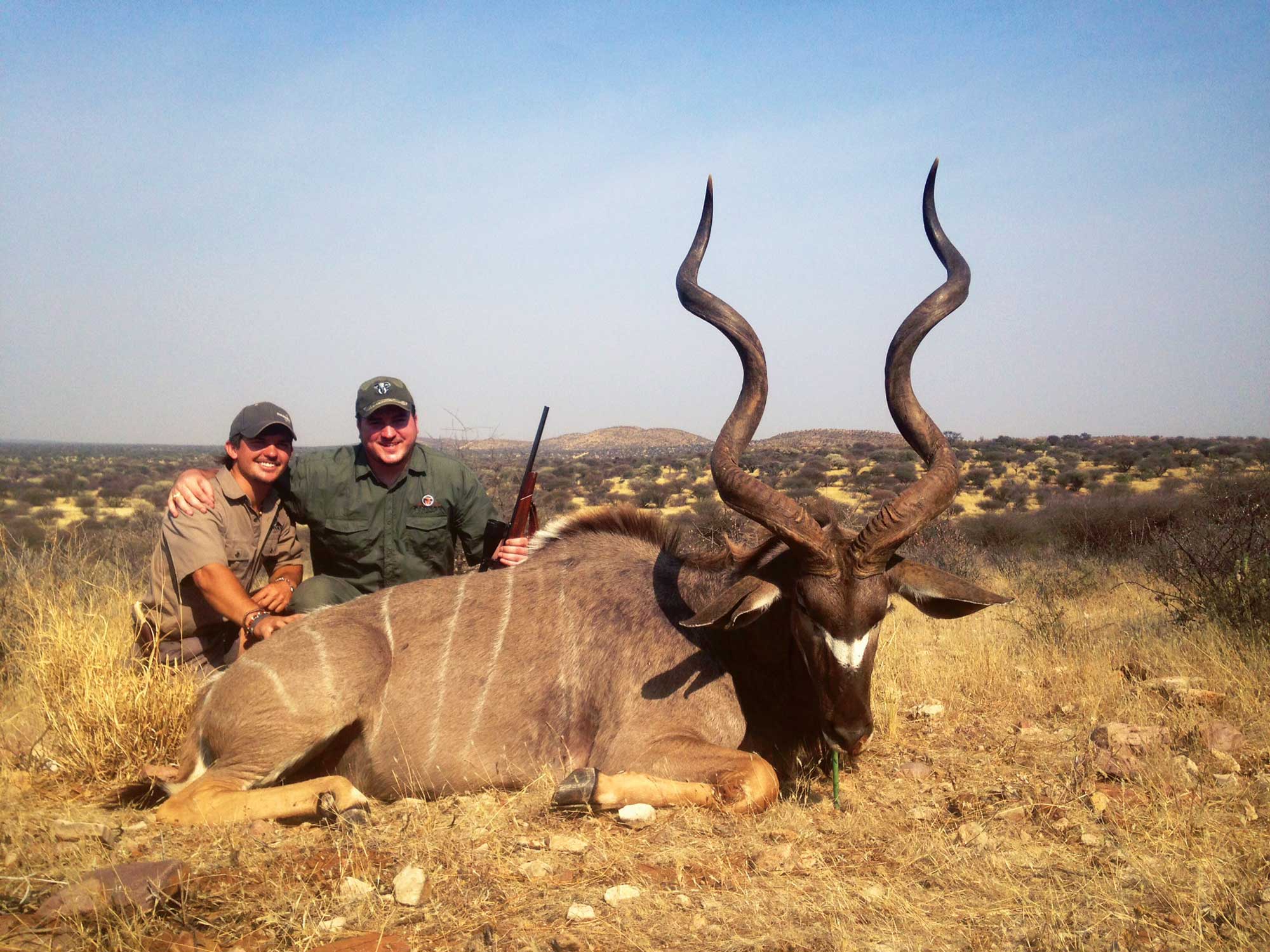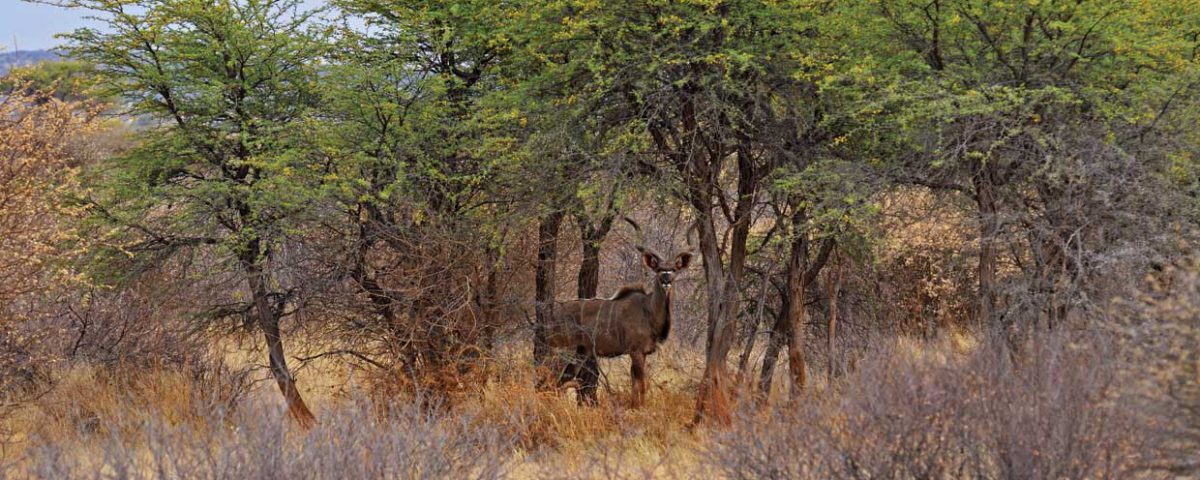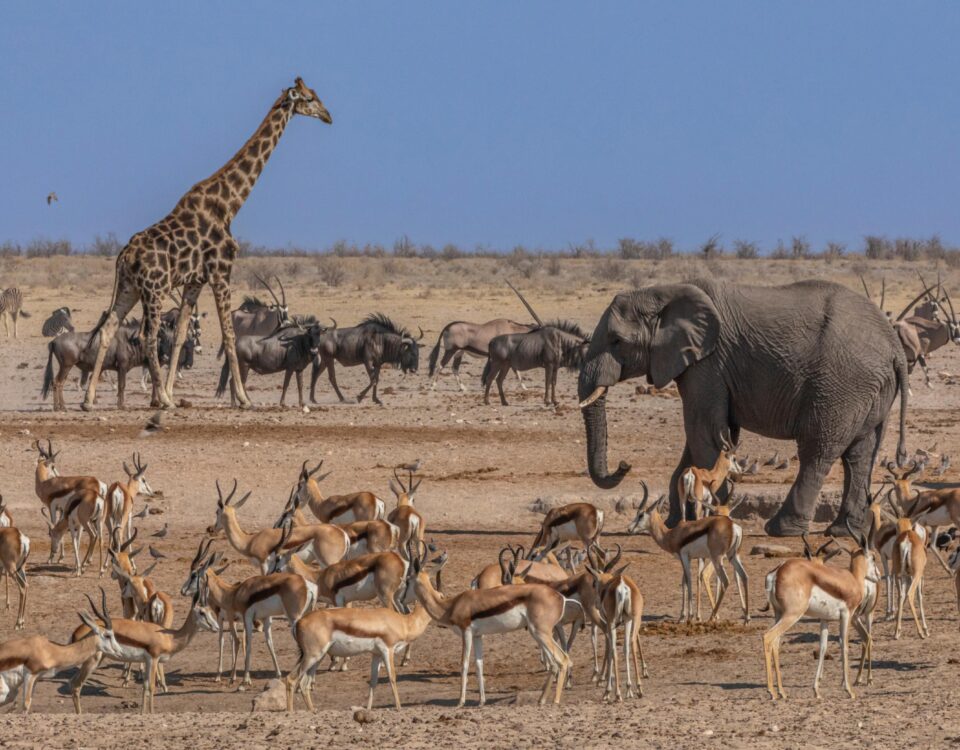| Main photo ©Jacques Strauss

The Omaheke – a place of discovery and adventure
June 8, 2016
A two-fold approach to kudu disease control
June 9, 2016Lightning cracked across the sky and steely-black storm clouds gathered over Namibia’s hills. A steady wind froze my cheeks stiff. Inside, a burning passion warmed my spirit: We were after my favourite quarry.
O ur crew consisted of my faithful tracker and driver, Moses, and Doug Dry and his son Joey from Texas, USA. This hunt had been a long time coming – Joey dreamt of hunting the African savannahs since he was a lad. His father turned the dreams into reality on Joey’s 27th birthday.
As we stopped at the first hill, I got off from the back of the vehicle, with Moses trailing to scan the valleys below for any sign of kudu. Doug and Joey would wait in the vehicle. It was rather difficult to climb the tall boulders with cold and stiff legs. After a sniff or two from my running nose, we sat down at the summit to glass the valleys below. The sun broke through the clouds as if there hadn’t been a cloud in the sky 30 minutes ago, lighting up the granite rocks underneath us like a bulb in the night. Below were numerous large camel thorn trees and near them thick patches of black-hook bushes scattered in such perfect fashion.
But the fact of the matter still remains: This year it is very hard to get a kudu bull exceeding the 50 inch mark. You have to hunt hard to break that barrier. That’s the fun part though. It’s tough and you have to work for a good trophy.
One thing was certain as the coming day – we were in superb kudu country. The ridges, saddles and crests formed by these mountains provide the perfect solitude that a kudu bull seeks. As I glassed, Moses rolled a thin cigarette for himself, in old fashion from a piece of newspaper, adding just the right amount of tobacco and carefully rolling it tight.
I sat thinking: A good fisherman would try to think like a fish. But these valleys were simply devoid of kudu.
“If I were a kudu bull, this is where I would be”, my thoughts reassured me. Protein-rich camel-thorn pods provide a good source of protein this time of the year, which makes it ideal for kudu bulls that just finished rutting. Besides, this place is isolated, quiet and peaceful. A perfect mixture to a successful kudu hunt.
After a while I sent Moses to join our clients waiting in the vehicle. I would continue to trek over the boulder and through the high grass, trying to find the kudu hiding place.
As I walked to the next peak, about a mile away, to glass the adjacent saddle, my eye kept probing shadows hoping to see a glance of a spiral horn. That’s the magic of Africa: you never know what is behind the next bush. This rush is why we hunt. It’s the beat of the drum, it’s in our blood, and the thrill of the chase is food for the soul.
As I got to the top of the little peak I selected a boulder to sit on and slowly scanned the mountain side and saddle. The sun was shining brightly on the granite boulders, the kudu bush so contrastingly green. A lone oryx bull browsing on the large camel-thorn trees beneath me, in the distance a herd of hartebeest warming in the sun. Glassing… Probing for a hint of a spiral-horn hidden in the shrub. Nothing.
As my thoughts wept another tear, I glanced back to the thick patch of kudu bush near the middle of the crest of the hill in hope. If there was nothing, we would have to go to a new area.
Wait….
There was a movement in the greenery of kudu bush! “Okay, Jacques, hold it…focus, what is it?” my mind spoke to me. A chill ran down my spine. My heart kicked into overdrive and my shallow breaths got shallower. A silhouette of an ivory tipped spiral horn showed against the blue August sky. A kudu bull was feeding gracefully, horns swaying. Disappearing over the horizon like no other species.
I knew this was a bull we could not let go. The forward pointing tips and the deep curling horns were a sign of his age. He was a perfect trophy. I horse-shoed the crest to get into a favourable wind position and that would also be the ideal place for Joey to meet up with me.
A short discussion was held, and Joey and I left the vehicle with the wind in our faces. We walked fast until we rounded the peak. Now we were in a favourable position to stalk in closer to where the kudu bull was…slowing to make minimum noise. Step by careful step. The voice in my head reminded me again: “They are not called the grey ghost for nothing”…
We silently walked 30 yards alongside the kudu bush thicket right where the peak meets the red Kalahari sand and tall camel-thorn trees. Rifle ready, shooting sticks ready.
“This year it is very hard to get a kudu bull exceeding the 50 inch mark. You have to hunt hard to break that barrier. That’s the fun part though. It’s tough and you have to work for a good trophy.”

Probing for any movement. Palms sweaty, knees weak and heavy. This was the moment. The tension hung like a skunk’s scent.
We were there…right there. At the exact spot where he was 40 minutes ago. He couldn’t be far. He should be here. Somewhere… Eyes probing, scanning and searching.
The great Ernest Hemingway hunted the grey ghost of Africa many a time without any luck. Were we doomed by the same ill luck? I hoped not…
I motioned to Joey to halt, edging forward onto a big boulder to get a better view – and locked eyes with the kudu bull 30 yards away. The stare lasted for a mere 10 seconds before he darted off. His spiral horns rocking back and forth like a rodeo bull with each stride, tail held high… Horns deeply spiralling, with heavy boss and tipped with white gold. A sure heart stopper for any hunter.
I looked back at Joey. He pointed with a dazed pale face and lips mumbling “kudu, kudu”. With a thumbs up, signalling “I’ve seen the bull”, we hurried off after our quarry hoping to see it fleeing the scene and getting a shot.
In vain. We were left with a signal track in the red soil.
Turning to Joey I said: “We are not leaving this kudu today. We must get it. Even if it’s a difficult shot – take it.” We had a small chance of catching up with him, but a small chance does not mean ‘no chance’. I fixed my eyes on the track and we were off… The clouds rolled away and the sun ruled the sky. It was a slow and laborious tracking session calling for great focus.
Judging the kudu bull’s speed by looking at his tracks, we followed at a good pace matching his. When the tracks showed that he was now walking, we slowed down. A slight breeze picked up. The bull made headway straight upwind.
I paused and knelt down on one knee to study the track. Closing my eyes I envisioned the bull: head lowered to duck this low hanging branch, his beard slightly blown by the gentle breeze and his feet sinking deep into the soil. A true monarch that played the sands of time wisely. We continued. I knew we would catch up with him soon. Hopefully before the start of the big hill.
Our eyes angling for a moment’s hint of a horn gleaming in the midday sun.
I stopped to glass the side of the hill – and there he was, 300 yards away minding his own business as he was unsuspectingly heading uphill. I signalled to Joey to follow close behind. We rushed as quietly as a hurried man in tall grass. From bush to bush. Stopping at a tall black-thorn tree as the kudu bull approached a gap on the hill. I threw up the sticks and Joey was on them with a single movement. Rifle ready, cartridge chambered. “Joey, do you see him?” I murmured urgently. “He is coming to the gap… Watch the gap.” “Aahh, there he is”, Joey responded.
The kudu bull entered the gap. Horns greater than ever. He paused impressively in the gap. “Now! Take him!” I whispered. The 30-06 BSA reverberated along the mountain. I heard the bullet hit home and saw the bull leap. He bucked, went forward a bit and stopped with bated breath. I watched him through my binos. Joey put in a follow-up shot and the bull was down.
We made a slow uphill climb. Backs sweaty and breathing heavily. The tension was building like in a good horror film as we approached the downed kudu bull. I wanted to hold his horns in my hands so badly that I caught myself walking faster and faster. My heart skipped a beat. His horns – dark chocolaty, spiralling deeply and tipped with ivory. His body was scarred and beaten. He was a fighter. A true Monarch of this African wilderness – a mighty ambler who knew no boundaries. Turning to Joey I said: “My friend, you don’t know what you have here… you just don’t know.”
This article was first published in the HUNTiNAMIBIA 2015 issue.


